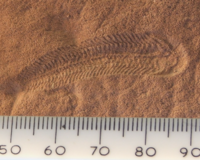Ediacaran biota
| Forms of Ediacaran fossil | |
|---|---|
| The earliest discovered potential embryo, preserved within an acanthomorphic acritarch. The term 'acritarch' describes a range of unclassified cell-like fossils. | |
| Tateana inflata (= 'Cyclomedusa' radiata) is the attachment disk of an unknown organism. Metric scale. |  |
| A cast of the quilted Charnia, the first accepted complex Precambrian organism. Charnia was once interpreted as a relative of the sea pens. |  |
| Spriggina was originally interpreted as annelid or arthropod. However, lack of known limbs, and glide reflected isomers instead of true segments, rejects any such classification despite some superficial resemblance. |  |
| Late Ediacaran Archaeonassa-type trace fossils are commonly preserved on the top surfaces of sandstone strata. |  |
| Epibaion waggoneris, chain of trace platforms and the imprint of the body of Yorgia waggoneri (right), which created these traces on microbial mat. |  |
| Biota ranges |
|---|

|
| Axis scale: millions of years ago, dated with U/Pb of zircons |
The Ediacaran (/ˌiːdiˈækərən/; formerly Vendian) biota consisted of enigmatic tubular and frond-shaped, mostly sessile organisms that lived during the Ediacaran Period (ca. 635–542 Mya). Trace fossils of these organisms have been found worldwide, and represent the earliest known complex multicellular organisms. The Ediacaran biota radiated in an event called the Avalon explosion, 575 million years ago, after the Earth had thawed from the Cryogenian period's extensive glaciation. The biota largely disappeared with the rapid increase in biodiversity known as the Cambrian explosion. Most of the currently existing body plans of animals first appeared in the fossil record of the Cambrian rather than the Ediacaran. For macroorganisms, the Cambrian biota appears to have completely replaced the organisms that dominated the Ediacaran fossil record, although relationships are still a matter of debate.
The organisms of the Ediacaran Period first appeared around 600 million years ago and flourished until the cusp of the Cambrian 542 million years ago, when the characteristic communities of fossils vanished. The earliest reasonably diverse Ediacaran community was discovered in 1995 in Sonora, Mexico, and is approximately 600 million years in age, pre-dating the Gaskiers glaciation of about 580 million years ago. While rare fossils that may represent survivors have been found as late as the Middle Cambrian (510 to 500 million years ago), the earlier fossil communities disappear from the record at the end of the Ediacaran leaving only curious fragments of once-thriving ecosystems. Multiple hypotheses exist to explain the disappearance of this biota, including preservation bias, a changing environment, the advent of predators and competition from other life-forms.
...
Wikipedia

